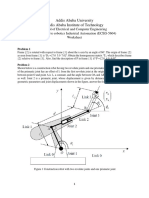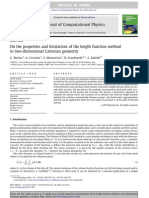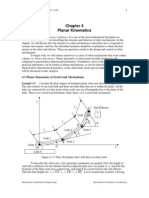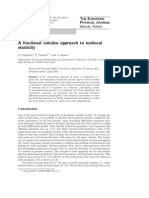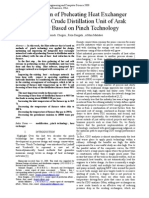8 DOF Redundant Robot
8 DOF Redundant Robot
Uploaded by
Xavier WallerCopyright:
Available Formats
8 DOF Redundant Robot
8 DOF Redundant Robot
Uploaded by
Xavier WallerCopyright
Available Formats
Share this document
Did you find this document useful?
Is this content inappropriate?
Copyright:
Available Formats
8 DOF Redundant Robot
8 DOF Redundant Robot
Uploaded by
Xavier WallerCopyright:
Available Formats
Positioning the End Eector of an
8-DOF Redundant Manipulator
Xavier A. Waller
EECE/ME 371
Robotics Final Project
Vanderbilt University
December 4, 2010
Prepared in L
A
T
E
X
1 Introduction
The purpose of my nal project was to demonstrate the validity of utilizing the in-
verse kinematics of a manipulator to accurately position its end eector. An 8-degree-
of-freedom (DOF) redundant manipulator was created using ROBOSIM as a tool for
visualization and using MATLAB and Mathematica as computational tools to facilitate
the analysis.
2 Developing the Model
ROBOSIM is a robot simulation package developed by faculty at Vanderbilt University.
It allows one to build a 3D model of a robotic manipulator and simulate its dynamic
behavior by inputing the inverse kinematics for the manipulator in question. Such a
tool is invaluable when it comes to designing and testing novel robotic models before
fabrication. Using the software, an 8-DOF manipulator was built in ROBOSIM (Fig.
1) and is comprised of 8 revolute joints (4 truncated-conical sections and 4 spherical
sections). Each spherical section allows for rotation of its respective truncated-cone about
the spheres x-axis while the cones themselves are free to rotate about their respective
z-axes
1
.
Figure 1: 8-DOF Manipulator model in ROBOSIM at the home position.
1
The components are color-coded for clarity. The blue spherical section corresponds to the blue
conical section, and so on for each of the three remaining pairs of spheres and cones.
1
3 Background
In order to position an end eector generally in 3-space, a minimum of six joints are
needed due to the fact that 6 degrees of freedom are needed for such positioning, namely
x, y, z,
x
,
y
,
z
, where x, y, and z are linear displacements and
i
is the rotation about
the i
th
axis [1]. There are two areas of concern with kinematic manipulations of robotic
manipulators: forward and inverse kinematics. The forward kinematic problem is: given
the joint parameters of a manipulator, what are the position and orientation of the end
eector
2
? The inverse kinematic problem, conversely, is: given a desired position and
orientation of the end eector, what joint angles are needed to achieve this goal? As
one may suspect, the computation of the inverse kinematics are generally much more
involved than the computation of the corresponding forward kinematics. This problem
becomes much more complicated when one introduces redundancies in the manipulator
to be analyzed. This is due to the fact that extraneous parameters cause the number of
potential solutions to increase.
3.1 General Solution Strategy
The general solution to an inverse kinematic problem always begins with the calculation
of the forward kinematics of the manipulator-end eector assembly via the Denavit-
Hartenberg (D-H) Parameters in order to develop a link transformation matrix, T, which
transforms the frame of the base (usually the starting frame) to some new frame (usually
the end eector frame). Fig. 2(b) shows a sample table to demonstrate the calculation
of the Denavit-Hartenberg parameters for a simple 3 DOF planar manipulator. The i
refers to the i
th
link,
i1
and a
i1
refer to the previous links joint angle and displace-
ment, respectively, and d
i
and
i
refer to the current links displacement and joint angle,
respectively.
(a) A three-link, planar manipulator (b) D-H Parameters
Figure 2: Notice that the values of the
i
s in (a) as well as the values for the L
i
s correspond the the
D-H chart shown in (b)[1].
The transformation matrix for the i
th
link with respect to the previous link is given
by:
2
In general, any link between the base of the robot and the end eector is acceptable, although one
is generally concerned with the explicit positioning of the end eector itself.
2
i
i1
T =
_
_
cos(
i
) sin(
i
) 0 a
i1
sin(
i
) cos(
i1
) cos(
1
) cos(
i1
) sin(
i1
) sin(
i1
)d
i
sin(
i
) sin(
i1
) cos(
i
) sin(
i1
) cos(
i1
) cos(
i1
)d
i
0 0 0 1
_
_
(1)
To determine the transformation matrix,
0
n
T, relating the base frame to the end eector,
one simply multiplies all n of the transformation matrices together such that:
0
n
T =
0
1
T
1
2
T
2
3
T ...
n2
n1
T
n1
n
T (2)
=
_
_
r
11
r
12
r
13
p
x
r
21
r
22
r
23
p
y
r
31
r
32
r
33
p
z
0 0 0 1
_
_
(3)
where n is the total number of frames and p
x
, p
y
, and p
z
are the nal x-, y-, and z- positions
of the end eector, respectively
3
. These three values are then utilized to calculate the
Jacobian, which is paramount to deriving the inverse kinematics of the manipulator.
3.2 Jacobian
The Jacobian of a transformation is a time-varying, linear transformation which maps
the velocities from one frame to another having dimensions m x n such that the number
of rows, m, are the degrees of freedom of the workspace in question and the columns, n,
are the total number of joints. As stated earlier, since navigation in 3-space involves 6
DOF, a Jacobian model of a manipulator in 3-space would have to have m =6 in order
to meet the translation and position requirements demanded.
To calculate the Jacobian, one determines the partial derivatives of the position vector
[p
x
, p
y
, p
z
]
T
obtained from Eq. 3 and the partial derivatives of the angles of rotation about
the x-, y-, and z-axes of the end eector frame, [, , ]
T
, with respect to each of the
joint parameters {
1
,
2
, . . . ,
8
}, where
i
is either a linear parameter, d
i
, or an angular
parameter,
i
. This process is shown in Eq. 4.
J() =
_
_
p
x
q
1
p
x
q
2
p
x
q
3
p
x
q
4
p
x
q
5
p
x
q
6
p
x
q
7
p
x
q
8
p
y
q
1
p
y
q
2
p
y
q
3
p
y
q
4
p
y
q
5
p
y
q
6
p
y
q
7
p
y
q
8
p
z
q
1
p
z
q
2
p
z
q
3
p
z
q
4
p
z
q
5
p
z
q
6
p
z
q
7
p
z
q
8
q
1
q
2
q
3
q
4
q
5
q
6
q
7
q
8
q
1
q
2
q
3
q
4
q
5
q
6
q
7
q
8
q
1
q
2
q
3
q
4
q
5
q
6
q
7
q
8
_
_
(4)
3
Due to the nature of the calculation of the nal total transformation from the base frame to the end
eector, p
x
, p
y
, and p
z
are necessarily functions of the D-H Parameters.
3
The vector
is used to denote {
1
,
2
, . . . ,
8
} and the Jacobian can be related to the
linear and angular velocity vectors of the manipulator by:
_
_
v
x
v
y
v
z
z
_
_
= J(
1
,
2
, . . . ,
8
)
_
8
_
_
(5)
where the left-hand side of Eq. 5 is the concatenation of the vectors representing linear
and angular velocities. This relationship can be expressed more succinctly as:
total
= J()
(6)
where
total
is equivalent to the left-hand side of Eq. 5. and
is the time rate of change
of the joint parameters. Because this project was only concerned with positioning the
manipulator,
total
can be replaced with = [v
x
, v
y
, v
z
]
T
. As a consequence, only the
rst three rows of J() are necessary for the calculation of position, which simplies the
analysis. This new matrix will be referred to as J
s
() The new relationship becomes:
_
_
v
x
v
y
v
z
_
_
= J
s
(
1
,
2
, . . . ,
8
)
_
8
_
_
(7)
3.3 Inverse Kinematics
Once the Jacobian was determined, the inverse kinematics of the system could be used
to provide a user with the required joint values to bring the manipulator to a desired
position. By algebraically manipulating Eq. 6, it was possible to solve for
as follows:
= J
1
() (8)
However, because the Jacobian for a redundant manipulator is necessarily non-square,
J
s
() is not invertible. Several methods have been developed for the determination of
a pseudo-inverse of the Jacobian, J
s
. The method utilized for this project was Singu-
lar Value Decomposition (SVD), which is capable of producing unique solutions for the
4
pseudo-inverse
4
. Using SVD to generate J
s
, the relationship between the joint parameter
vector,
, and the velocity vector, , then becomes:
= J
s
(9)
Next, the desired linear velocity, , was determined. This was performed by taking the
dierence between the current and desired position and scaling them by a constant, ,
which was determined empirically. This relationship is given as:
=
_
_
v
x
v
y
v
z
_
_
=
_
_
_
_
_
x
d
y
d
z
d
_
_
x
c
y
c
z
c
_
_
_
_
_
(10)
where the subscripts d and c represent the desired and current Cartesian positions
of the end eector, respectively. In general, the manipulator could be asked to move
from one end of its workspace to the opposite end. The ramications of a manipulator
instantaneously moving between two distant points are jerky motion and the need for an
innite amount of power with the former being highly undesirable and the latter being
physically impossible to achieve. To resolve this issue, the trajectory between the desired
position and current position were subdivided into discrete steps. The smaller these steps
are, the smoother the motion becomes
5
. Once the velocity was determined, it was plugged
into Eq. 9 to solve for the desired rate of change of the joint parameters,
. By utilizing
the following relationship, it then became possible to solve for the nal joint parameters
such that:
k+1
=
(11)
where the subscripts k and k + 1 correspond to the current set of intermediate joint
parameter values and the next set of intermediate joint parameter values, respectively.
Recall that the path from the current position to the desired position was subdivided.
Thus, the index k ranged from 1 to the number of subdivisions which was 10,000 for this
project. Furthermore, the variable represents a scaling constant
6
and was determined
empirically .
4 Results and Discussion
The values of and were determined to be 0.1 and 1.0, respectively. These values were
determined based upon how close the nal position of the manipulator was to the desired
(input) position. In this case, the actual positions either deviated by less than 2% from
the desired positions or were vastly dierent from the desired positions as shown in Tab.
I.
As the data illustrates, the actual output position of the system (x
a
, y
a
, z
a
) closely
matched the input positions (x
d
, y
d
, z
d
) in most cases. However, it is evident that there
4
MATLAB has the capability to perform the SVD.
5
This was achieved by utilizing the trajpar command in MATLAB starting at the current position
and ending at the desired position in 10,000 steps. A trajpar was used for each of the x-, y-, and z-
directions.
6
The scaling constants and have units of [seconds] and [1/second], respectively.
5
Table I. Measured Values
Run Desired Position Output Position
No. x
d
y
d
z
d
x
a
y
a
z
a
1 40 13 0 35.30 37.20 1.86
2 20 20 20 19.99 19.20 20.19
3 -2 36 20 -1.98 35,94 20.02
4 -30 22 42 -29.95 22.11 41.99
5 -30 22 56 -24.00 31.30 44.57
6 -30 22 55 5.21 11.69 14.83
7 -50 22 5 -48.90 41.38 4.95
8 56 56 56 25.00 28.00 34.00
9 0 0 0 0.02 -0.01 0.04
10 0 0 56 0.02 0.09 55.98
11 0 56 56 16.15 -29.80 6.88
12 0 6 32 0.02 5.96 32.08
13 0 6 32 0.02 5.96 32.08
are some trials when the output position deviated signicantly from the desired position.
An extreme example of such deviation is Run No. 8 where the input position was (56,
56, 56) and the output position was (25.00, 28.00, 34.00). In this case, none of the values
were in an acceptable range. A less extreme example is Run No. 7 where the input
position was (-50, 22, 5) and the output was (-48.90, 31.38, and 4.95). In this case, the
x- and z- coordinates were in an acceptable range, however; the y-coordinate was o.
The common factor between both of these cases is the fact that the manipulator has
approached a workspace singularity at its outer boundary. Since the workspace of this
particular manipulator is the volume of a sphere with a radius of 56 units and due to the
fact that the approaching of the outermost radius causes the loss of one or more degrees
of freedom of the manipulator, which causes certain positions to be unattainable[1], the
closer one approaches the point (56, 56, 56), the more unpredictable the manipulator
behaves. Thus, the eective operating range of this manipulator should be well within
the maximum radius that can be reached by the manipulator. Run No. 1, however,
shows a deviation which is not expected according to the statement about workspace
singularities. It is likely that a workspace singularity somewhere in the interior occurred,
which presents itself when one or more axes of a manipulator align (or approach such
alignment). Finally, , it was stated earlier without proof that the SVD produces a unique
solution for the pseudo-inverse of the Jacobian, J
. Runs No. 12 and 13 are a validation
of the fact that the SVD algorithm consistently produces the same J
for a given set of
parameters.
5 Conclusion
This exercise has demonstrated the validity of utilizing the inverse kinematics of a manip-
ulator to control and position its end eector. Care must be avoided when approaching
singular congurations as these will cause the robot to behave in unexpected ways, pos-
sibly causing equipment damage or personal injury. While the SVD method produces
unique solutions to the Jacobian, the Jacobian method of positioning an end eector is
6
maximally eective when exact positioning is not required. Thus, in scenarios such as
welding, where high precision is necessary, other methodologies should be used to posi-
tion the end eector. Such methodologies are obviously possible due to the fact that the
human body, for instance, is capable of positioning its many redundant end eectors with
a remarkable degree of accuracy despite the fact that the control schemes used for such
positioning are high in noise and uncertainty.
References
[1] John J. Craig. Introduction to Robotics: Mechanics and Control, 2nd Ed. Addison-
Wesley, 1989.
7
You might also like
- REVISED IHOMP SAT v2 - For HospitalsDocument13 pagesREVISED IHOMP SAT v2 - For HospitalsMeme Lang100% (2)
- Lab Manual PDFDocument24 pagesLab Manual PDFvrukshaNo ratings yet
- 4.4 Edit (Levenshtein) DistanceDocument5 pages4.4 Edit (Levenshtein) DistancemadersionNo ratings yet
- WorksheetDocument3 pagesWorksheetdanielNo ratings yet
- Lab 3 Mapping Stock and Flow and Metal SimulationDocument10 pagesLab 3 Mapping Stock and Flow and Metal SimulationPard TeekasapNo ratings yet
- A Complete Analytical Solution To The Inverse Kinematics of The Pioneer 2 Robotic ArmDocument7 pagesA Complete Analytical Solution To The Inverse Kinematics of The Pioneer 2 Robotic ArmWm HanifNo ratings yet
- Kinmatics Invese CalcuDocument6 pagesKinmatics Invese CalcukinfegetaNo ratings yet
- Direct and Inverse Kinematics of A Serial ManipulatorDocument11 pagesDirect and Inverse Kinematics of A Serial ManipulatorjdaudpotoNo ratings yet
- Kinematic Model of Robot Manipulators: Claudio MelchiorriDocument170 pagesKinematic Model of Robot Manipulators: Claudio MelchiorriMohammad SadiqNo ratings yet
- Lab 2 ManualDocument11 pagesLab 2 ManualJagadish ChandraNo ratings yet
- Kinematics of Robots: Alba Perez GraciaDocument15 pagesKinematics of Robots: Alba Perez GraciaLin JiangNo ratings yet
- FANUC 200ib Robot DescriptionDocument5 pagesFANUC 200ib Robot DescriptionAnurag KesariNo ratings yet
- Complex-Valued Matrix Differentiation: Techniques and Key ResultsDocument12 pagesComplex-Valued Matrix Differentiation: Techniques and Key ResultsIshan ShethNo ratings yet
- 10 Scar DoDocument12 pages10 Scar DotringuyentttNo ratings yet
- Modelling Crack Growth by Level Sets: M. Stolarska, D.L. Chopp, N. Moës, and T. BeltyschkoDocument10 pagesModelling Crack Growth by Level Sets: M. Stolarska, D.L. Chopp, N. Moës, and T. BeltyschkoAlexgh1993No ratings yet
- Direct and Inverse KinematicsDocument25 pagesDirect and Inverse KinematicsMyagmarbayar NerguiNo ratings yet
- Inverse Kinematics Problem (Ikp) of 6-Dof Manipulator by Locally Recurrent Neural Networks (LRNNS)Document5 pagesInverse Kinematics Problem (Ikp) of 6-Dof Manipulator by Locally Recurrent Neural Networks (LRNNS)yousif al mashhadanyNo ratings yet
- Ma 2000 PDFDocument18 pagesMa 2000 PDFMuhammad ZulfiqarNo ratings yet
- 小论文 - Modeling of flexible non-linear dynamic links in Nano-Positioning Motion SystemsDocument10 pages小论文 - Modeling of flexible non-linear dynamic links in Nano-Positioning Motion Systems侯涛No ratings yet
- Chapter 4Document8 pagesChapter 4marifs2002No ratings yet
- Study of Rotor-Bearing Systems Using Campbell DiagramDocument4 pagesStudy of Rotor-Bearing Systems Using Campbell DiagrammishraenggNo ratings yet
- Improved Approach For Mobile Robotics in Pattern Recognition 3DDocument8 pagesImproved Approach For Mobile Robotics in Pattern Recognition 3DSelva GanapathyNo ratings yet
- The Spherical Four-Bar Mechanism: Optimum Synthesis With DE Algorithm and Animation Using MathematicaDocument8 pagesThe Spherical Four-Bar Mechanism: Optimum Synthesis With DE Algorithm and Animation Using Mathematicaadan25tulaNo ratings yet
- forward and inverse kinematics A&RDocument5 pagesforward and inverse kinematics A&RAffan KhanNo ratings yet
- Reference Trajectory Tracking For A multi-DOF Robot Arm: 10.1515/acsc-2015-0033Document15 pagesReference Trajectory Tracking For A multi-DOF Robot Arm: 10.1515/acsc-2015-0033Zafer GökNo ratings yet
- Function Generation Using Freudenstein's EquationDocument15 pagesFunction Generation Using Freudenstein's Equationvenkatanaveen306No ratings yet
- finsler (1)Document38 pagesfinsler (1)inimgharNo ratings yet
- Modelling and Control of A Modular Redundant Robot ManipulatorDocument20 pagesModelling and Control of A Modular Redundant Robot Manipulatorkurts010No ratings yet
- Chapter16 Kinematics of RobotsDocument13 pagesChapter16 Kinematics of RobotsThasarathan RavichandranNo ratings yet
- Solution of Inverse Kinematics For SCARA Manipulator Using Adaptive Neuro-Fuzzy NetworkDocument8 pagesSolution of Inverse Kinematics For SCARA Manipulator Using Adaptive Neuro-Fuzzy NetworkijscNo ratings yet
- Analytical Inverse Kinematics Algorithm of 5 Dof Robot ArmDocument13 pagesAnalytical Inverse Kinematics Algorithm of 5 Dof Robot ArmsathyaNo ratings yet
- Xiicleee RBP 1754revDocument6 pagesXiicleee RBP 1754revrbargallo0No ratings yet
- A General Approach To Multiple Precesion Point Motion Generation by 4-Bar LinkageDocument25 pagesA General Approach To Multiple Precesion Point Motion Generation by 4-Bar LinkageAbhinaba MaitraNo ratings yet
- Bad GeometryDocument5 pagesBad GeometryMilica PopovicNo ratings yet
- Grid GenerationDocument4 pagesGrid GenerationNadia SoussouNo ratings yet
- Analysis of The Inverse Kinematics For 5 DOF Robot Arm Using D-H ParametersDocument6 pagesAnalysis of The Inverse Kinematics For 5 DOF Robot Arm Using D-H ParametersGayathri BhatNo ratings yet
- FKE ^0 IKE Solving MethodsDocument7 pagesFKE ^0 IKE Solving Methodssabarishh.04No ratings yet
- Practice ReportDocument11 pagesPractice Reportcheuk.ng.panteNo ratings yet
- Direct Kinematic Modeling of 6R Robot Using Robotics ToolboxDocument4 pagesDirect Kinematic Modeling of 6R Robot Using Robotics ToolboxNedim BabicNo ratings yet
- A Study of The Representation of Cracks With Level Sets: Marc DuflotDocument54 pagesA Study of The Representation of Cracks With Level Sets: Marc DuflotRasagya MishraNo ratings yet
- Hierarchical Matrices and Adaptive CrossDocument10 pagesHierarchical Matrices and Adaptive CrossChee Zhen QiNo ratings yet
- Short Papers: The Tricept Robot: Dynamics and Impedance ControlDocument6 pagesShort Papers: The Tricept Robot: Dynamics and Impedance ControlPrakashNo ratings yet
- A Complete Generalized Solution To The Inverse Kinematics of Robots-UgADocument7 pagesA Complete Generalized Solution To The Inverse Kinematics of Robots-UgAArijit RoyNo ratings yet
- UNIT - 7.PDF Engg MathDocument99 pagesUNIT - 7.PDF Engg MathsudersanaviswanathanNo ratings yet
- Matecconf mms2018 06004Document8 pagesMatecconf mms2018 06004Ethan WilsonNo ratings yet
- Siam J. N A 1992 Society For Industrial and Applied Mathematics Vol. 6, No. 6, Pp. 1716-1740, December 1992 011Document25 pagesSiam J. N A 1992 Society For Industrial and Applied Mathematics Vol. 6, No. 6, Pp. 1716-1740, December 1992 011Himanshu NayarNo ratings yet
- Complex-Valued Matrix Differentiation: Techniques and Key ResultsDocument30 pagesComplex-Valued Matrix Differentiation: Techniques and Key ResultschangeezaminiNo ratings yet
- Position Control of Pick and Place Robotic ArmDocument5 pagesPosition Control of Pick and Place Robotic Armavinashs2410_41108610% (1)
- Journal 11Document6 pagesJournal 11Eccker RekcceNo ratings yet
- Potential Field Methods and Their Inherent Limitations For Mobile Robot NavigationDocument10 pagesPotential Field Methods and Their Inherent Limitations For Mobile Robot NavigationViet Nguyen TrungNo ratings yet
- A Fractional Calculus Approach To Nonlocal ElasticityDocument12 pagesA Fractional Calculus Approach To Nonlocal ElasticityABasiophilia LimpNo ratings yet
- ForwardandInverseKinematicAnalysisofRoboticManipulatorsIRJET V4I2286 PDFDocument11 pagesForwardandInverseKinematicAnalysisofRoboticManipulatorsIRJET V4I2286 PDFAshar HaroonNo ratings yet
- Engineering20101100005 44076873Document13 pagesEngineering20101100005 44076873Abdalla Mohamed AbdallaNo ratings yet
- Akima InterpolationDocument14 pagesAkima Interpolationmarcosipa70% (1)
- PerssonAndStrang MeshGeneratorDocument17 pagesPerssonAndStrang MeshGeneratorJeff HNo ratings yet
- C 1 Quadratic InterpolationDocument18 pagesC 1 Quadratic InterpolationSukuje Je100% (1)
- Unit 2Document19 pagesUnit 2AnasNo ratings yet
- Planar Robot KinematicsDocument7 pagesPlanar Robot Kinematicsasalifew belachewNo ratings yet
- Robot Manipulators: Modeling, Performance Analysis and ControlFrom EverandRobot Manipulators: Modeling, Performance Analysis and ControlNo ratings yet
- Student Solutions Manual to Accompany Economic Dynamics in Discrete Time, second editionFrom EverandStudent Solutions Manual to Accompany Economic Dynamics in Discrete Time, second editionRating: 4.5 out of 5 stars4.5/5 (2)
- Four Bar Linkage DynamicsDocument1 pageFour Bar Linkage DynamicsXavier WallerNo ratings yet
- Four Bar Linkage DynamicsDocument1 pageFour Bar Linkage DynamicsXavier WallerNo ratings yet
- Stephen Timoshenko CollectionDocument2 pagesStephen Timoshenko CollectionXavier WallerNo ratings yet
- Torsion of Non Circular BeamsDocument24 pagesTorsion of Non Circular BeamsXavier WallerNo ratings yet
- Sesame ChickenDocument1 pageSesame ChickenXavier WallerNo ratings yet
- 61 Spesifikasi PRIMAMED SCHWERT Dental Instrument Set For School-Kit UKGSDocument1 page61 Spesifikasi PRIMAMED SCHWERT Dental Instrument Set For School-Kit UKGSSarahNo ratings yet
- Real and Phantom Risks at The Petrol StaDocument15 pagesReal and Phantom Risks at The Petrol Stadimasruhin.fannyNo ratings yet
- Class 7Document44 pagesClass 7piyush varmaNo ratings yet
- Chapter 9AADocument24 pagesChapter 9AAIbraahim AbdiNo ratings yet
- SE&P Switch CatalogDocument183 pagesSE&P Switch CatalogtopbhhNo ratings yet
- WCECS2008 pp123-127Document5 pagesWCECS2008 pp123-127Syukri ShahNo ratings yet
- Extraction methods PDF - جستجوی GoogleDocument13 pagesExtraction methods PDF - جستجوی GoogleAshkan “A.N” Abbasi50% (2)
- Limnology Oceanography - 2024 - Gorski - Deep Learning of Estuary Salinity Dynamics Is Physically Accurate at A FractionDocument16 pagesLimnology Oceanography - 2024 - Gorski - Deep Learning of Estuary Salinity Dynamics Is Physically Accurate at A Fractionl guoNo ratings yet
- How Would You Like Your Haircut TodayDocument4 pagesHow Would You Like Your Haircut TodayRessielyn Kates CaperinaNo ratings yet
- Coordinate Systems: 1 Bhanu Prakash at EEEDocument19 pagesCoordinate Systems: 1 Bhanu Prakash at EEERamuNo ratings yet
- Sons of NoahDocument12 pagesSons of NoahJulio Iglasias100% (2)
- FM and Service DeliveryDocument3 pagesFM and Service DeliveryrenvNo ratings yet
- June 2009 Nle HirapDocument35 pagesJune 2009 Nle HirapDavid BrilloNo ratings yet
- Analysing A Jazz Solo - Straight, No Chaser (Miles Davis)Document2 pagesAnalysing A Jazz Solo - Straight, No Chaser (Miles Davis)Ritik AswaniNo ratings yet
- Es 103 - Module 7 - Torsion of Thin Walled Tubes - Helical SpringDocument36 pagesEs 103 - Module 7 - Torsion of Thin Walled Tubes - Helical Springyrbbwababa05No ratings yet
- PBF Power-Building PDFDocument6 pagesPBF Power-Building PDFmanuhazeNo ratings yet
- S. Fedorciucova - V. Calmas - M. DamaschinDocument13 pagesS. Fedorciucova - V. Calmas - M. DamaschinAnna BalanNo ratings yet
- Defining Relative ClausesDocument3 pagesDefining Relative ClausesanytanyaNo ratings yet
- Income Tax Calulator With Functions and Robus Validation: PFC - Assignment - Part 1Document4 pagesIncome Tax Calulator With Functions and Robus Validation: PFC - Assignment - Part 1tran nguyenNo ratings yet
- Swimming Pool Design StandardsDocument27 pagesSwimming Pool Design StandardsChristine Joy Marto100% (1)
- Novice Teachers Training and Support NeeDocument13 pagesNovice Teachers Training and Support Neezgr2yhf7wpNo ratings yet
- TS 2013 Catalog EmailDocument28 pagesTS 2013 Catalog EmailRachel GordonNo ratings yet
- MUS331 - History of Jazz: Term ProjectDocument8 pagesMUS331 - History of Jazz: Term ProjectEge DalyanNo ratings yet
- ATA13 Fed ExDocument31 pagesATA13 Fed Exprzytul2007No ratings yet
- Chap 10Document17 pagesChap 10N.S.RavikumarNo ratings yet
- Shivaji University Migration FormDocument4 pagesShivaji University Migration Formdipak593950% (2)
- Check Dam 2023-05-15 14 - 00 - 06Document24 pagesCheck Dam 2023-05-15 14 - 00 - 06FedaNo ratings yet
- Ept20 20wa Parts ManualDocument88 pagesEpt20 20wa Parts ManualAdrian FerreyraNo ratings yet



